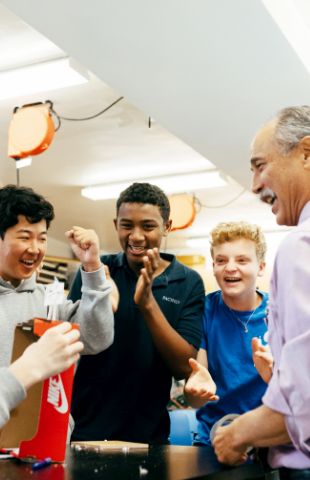Balancing Freedom and Choices
January 3rd, 2023
 When I am in social circles with high school students and other adults, the students are often asked, “What is your passion?” This is a common question asked by family, friends, relatives, counselors, and even teachers. I see the panic on the students’ faces as they search for possible answers. When my ninth grade son was asked that question, he quickly blurted out, “Real estate—I want to go into real estate. It’s something I’m considering.” When the crowd dwindled, I asked him about it. He told me he had no idea what to say, so he just made something up. We had a chuckle.
When I am in social circles with high school students and other adults, the students are often asked, “What is your passion?” This is a common question asked by family, friends, relatives, counselors, and even teachers. I see the panic on the students’ faces as they search for possible answers. When my ninth grade son was asked that question, he quickly blurted out, “Real estate—I want to go into real estate. It’s something I’m considering.” When the crowd dwindled, I asked him about it. He told me he had no idea what to say, so he just made something up. We had a chuckle.
Asking a high school student what they’re passionate about, in most cases, is a dead end. Most of them don’t have the foggiest idea. The question produces stress and creates false expectations. They walk away wondering why they aren’t studying five languages, writing a novel, or starting a business. Some go off to find a passion and feel as if something is wrong if nothing clicks. Most teenagers are just beginning to explore the world and putting their toes in the water. They are not ready to specialize but are looking at a wide variety of things. Perhaps they have several “likes” and not one passion. I know today I can’t identify one thing I am passionate about but many things I really enjoy, like cooking, sports, and reading. My adult children are the same way. Rather than one passion, they have many strong interests that bring joy and meaning to their lives. If a teenager has a developed passion, they should be encouraged. That is a great thing. However, we shouldn’t put that expectation on the vast numbers that have no idea. There is joy and purpose in having a breadth of interests.
Today young adults have what seems like unlimited options for their future. They have unprecedented freedom. There is not one thing they can do but many things. This can create anxiety and instability. Too many choices and freedom can paralyze them. Freedom is a good thing. However, for teens, freedom with guidance is the key. Most adults want to be “kind” and don’t want to get in the way, so they say things like, “You can do whatever you put your mind to,” or “Once you graduate, you’ll have a chance to go find yourself,” or “You’ll figure it out.” In the name of freedom, we simply cut ties and move to the side.
High school seniors aren’t ready for unlimited freedom nor do most of them want it. They need and want the wisdom of others, a partnership. We all need that.
If you grew up in the 1950s, you probably went to the same school as your parents, lived on the same block, shopped at the same stores, went to the same church, and took a similar job that you kept for many years. Things were stable and laid out. A young person knew the road ahead and had fewer choices.
In an effort to free ourselves from the conformity, boredom, diminished creativity, and lack of authenticity of the ’50s, the ’60s ushered in change. It was a correction. It brought radical individualism. We entered an era of freedom, individualism, and expressiveness and were asked to live authentic lives. It removed many of the restrictions from the past. However, at the same time, it loosened the bonds of community, family, church, and institutions that create stability. The correction solved one problem and created another.
Today we stand with our young adults and say, “You do you. Go live your best life.” The kids look back at us and think, “What does that even mean? Can you give me some help? I need some answers.” We have fewer expectations that our kids will take on our vision for life, politics, values, religion, or career. They are free to create. We have asked them to define their own concept of existence. We have privatized meaning and glorified personal choice, rejecting anything unchosen. Once upon a time, schools, neighborhoods, and families helped create a shared moral order. Today teenagers are asked to define their own moral order. Rather than follow the past, they are to choose the future.
A study at the Harvard Graduate School of Education on the topic of accomplishment versus character found that 80% of teenagers believed their parents cared more about their children’s accomplishments and resume than their character. The study surveyed 10,000 teenagers.
What teenagers need is freedom and choices with guidance and wisdom. Rather than us giving up and walking away, we need to stay in the game. We need to lean in and provide leadership. We are not simply fans watching from afar; we are coaches who have a strategic role with our young adult children. Of course, it is their life, and they are in control. However, to avoid the instability and anxiety that come with unlimited freedom, we need to help give them handles. Our kids are grasping for handles, and we are walking away. We don’t want to be controlling or judgmental; we want to be kind, so we don’t say much. We live in an era of kindness, not courage, and this has its downside. As parents, we need to have the courage and wisdom to lead and lean in, in a way that brings wisdom without control, guidance without grief. Our kids don’t want to be thrown to the wind. They may say they want us out of the picture, but deep down inside, they could use some counsel and support. All humans want this.
We need independence with connection or interdependence.
Here are some tips to help guide our kids through the myriad choices at their fingertips.
1. Four-Year Educational Plan – Create a four-year high school or college plan with them. We did that for all of our kids, and they appreciated it. It wasn’t Mom and Dad’s plan. It was their plan that we crafted together. We created several versions of it for them to edit and change. Rather than giving them a blank page for the educational plan, we filled it in together, and from time to time, we returned to it.
2. The College List – In the tenth grade, create a college list with them, something to give them an idea of what is out there. Include a variety of schools, from private to public and small to large. You know them well, and having your input early on is key. I have seen kids in October of their senior year with blank lists. They are lost, have no idea, and need something concrete. When I asked my daughter where she was thinking about going to school, she said she had no idea. She said, “You know me well. You have been out there far more than me. What do you think I should do?” So many kids are feeling this but don’t say it.
3. The Budget – Help them create a budget. Managing money can be foreign to kids. Partner with them, and give them some expertise.
4. Take Them to Work – Share more about your life, your world, and your job. Let them in on your journey. This will give them a bigger picture. One of the best things we did for our kids was take them to work from time to time. This gives them a glimpse of what is to come. If all they see you do is sit on the couch in leisure, they will have no idea about the next steps. Help them see the future.
It is good that our kids have independence and choice. To help them navigate it when we are tempted to back away, we need to provide a bit more leadership. We need to lean in, wisely pick our spots, and provide a partnership. It will be a partnership that will last a lifetime.
By Jim Knight, Head of School
Categories
Recent Articles
10 Reasons Content Box

10 Reasons to Choose Pacifica








